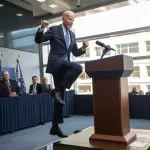The Federal Reserve has opted to slash interest rates by half a percentage point, a move that was clearly aimed at injecting some life into an economy battered by the reckless fiscal policies of the Biden-Harris administration. Financial markets initially responded with enthusiasm, though that lasted about as long as a refreshing summer breeze before reality set in. Despite a momentary lift, the grim underpinnings of America’s economy have not vanished with this half-hearted gesture.
The Fed’s chair, Jerome Powell, asserted that the economy is “basically fine.” This assertion could send anyone with a shred of common sense into fits of laughter—especially after examining the latest census data revealing that real median earnings for full-time workers have tumbled. The unfortunate truth is that American households have been dealt a poor hand since Biden took office, with real income failing to regain its footing post-pandemic. The only thing flourishing under this administration is the ever-mounting federal debt.
While Powell and his team may want to bask in the glow of a half-percentage cut, the reality is that the Fed’s actions are more akin to tossing a life raft to a sinking ship. Economists have been pointing out that the inflation rates still exceed wage increases, effectively leaving lower-income workers in an even tighter financial bind. The stark contrast between the success of the Trump administration’s economic policies and the fumbling grasp of the current regime is impossible to ignore.
Contrary to the sunny outlook Powell tries to project, there is a growing chorus of dissent from informed economists, who contend that the Fed’s tightening measures over the past year have already inflicted unnecessary damage on the economy. Their warnings suggest that the current interest rate cut could be woefully insufficient to stave off the repercussions of the Biden administration’s far-reaching and damaging policies. The picture painted by recent economic reports shows a pattern of disarray—a fact that is somehow brushed aside by those eager to downplay the impact of fiscal mismanagement.
The Federal Reserve cut interest rates by half a percentage point, indicating the possibility of more cuts in the future. While Fed Chair Jerome Powell asserts the economy is stable, recent Census Bureau data shows declining real median income,… https://t.co/AouRgJJed7
— The America One News (@am1_news) September 26, 2024
The chilling dynamic of rising federal spending and crippling regulations, launched into hyperdrive during the Biden presidency, has stifled genuine economic recovery. The government’s appetite for expansive spending coupled with burdensome regulations has led to this strange stay of execution for the economy. Borrowing is skyrocketing, consumer debt is ballooning, and the looming specter of recession is not so easily brushed aside. Instances of economic growth appear like mirages amidst the chaos, leaving many to wonder if the Fed’s latest gambit is intended to mitigate damage rather than cultivate growth.
In the broader picture, the Fed’s rate cut invites skepticism. Historically, when the Fed begins trimming interest rates, it often heralds the onset of a recession, or comes at the tail end of it. The question remains whether this latest rate cut will merely serve as a bridge over troubled water—one that won’t quite hold against the currents of a vastly overspent economy. There is little doubt that when looking at the economic contrasts between past administrations, the outlook under Biden remains disheartening, creating an alarming disconnect between rhetoric and reality.
If the nation is to avoid a complete economic tailspin, it will require a fundamental reckoning with the reckless spending and bloated bureaucracy that have characterized recent years. The Fed’s actions may be too little, too late, and Americans are left wondering just how long they can weather the storm created by policies that seem intent on siphoning prosperity from the everyday worker.




